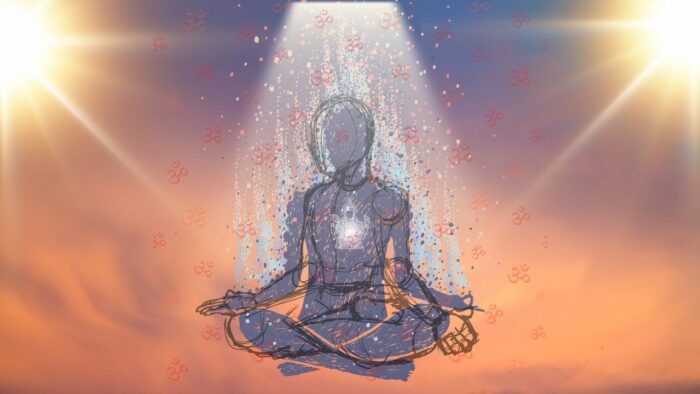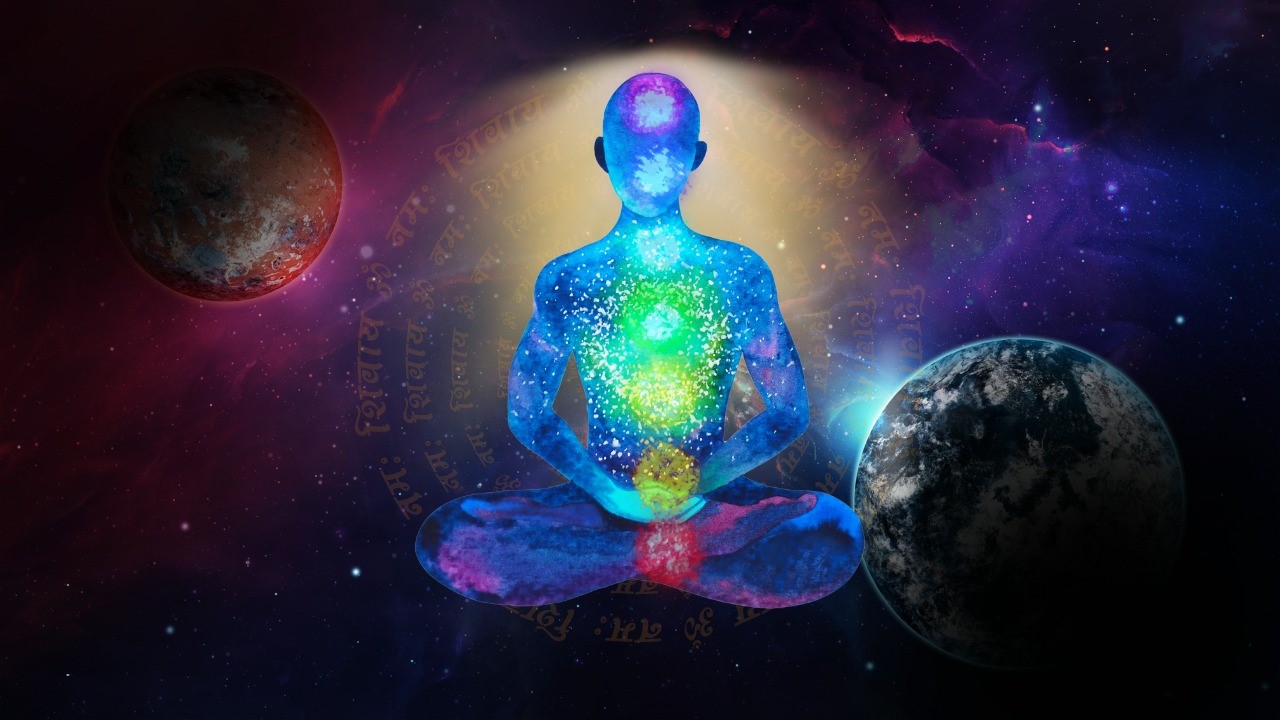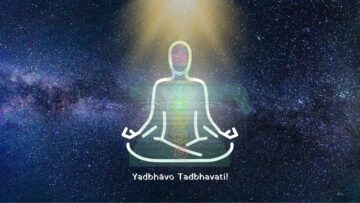Introduction
Śrī Krishnamacharya, renowned yoga master and teacher to the royal court of Mysore under the reign of Krishnaraja Wadiyar IV, was an adept yogī and equally a devout bhakta and bhagavata, unflinching in his śraddhā. Once when an insurance salesman asked him to take out life insurance, he replied, “Nārāyaṇa is my insurance. I have no need for any further insurance!” Such was his conviction, which shines through his teachings and his works.
Śrī Krishnamacharya composed a poem titled Dhyānamālika in just one day in 1971 with 34 verses, he said that this composition was on “certain yoga disciplines to prepare for worship.”
For him, dhyānam was in no way separate from worship and Dhyānamālikā was conceived by him as a guide to dhyānam. He was emphatic that the ultimate purpose of yoga was to kindle and nurture bhakti. Devoid of bhakti, yoga sadhana, he felt, would only lead to short lived benefits.
(Figure 1: Credit: krishnawellness.com – Sri Krishnamacharya)
This paper presents Śrī Krishnamacharya’s views and insights on the principles and practice of dhyānam as outlined in his work, Dhyānamālikā. It also incorporates some verses from another poem of Śrī Krishnamacharya, “Yogāñjalisāram,” in which he expresses clearly his views on Patañjali’s aṣṭāṅga pathway as the ideal pathway to attain the highest state of yoga.
T Krishnamacharya’s thoughts on Dhyānam in response to questions from his students
- What does dhyānam involve?
The foundations for dhyānam are dhyātā, dhyānam and dhyeyam. All three are beyond the perception of the senses. Therefore, they are called antara indriya viṣaya.
Among the three tattva-s, dhyātā (the jīva) and dhyeya (paramātma) are nityam (eternal) and avikārī (unchangeable). However, dhyānam, which is a nature of the mind in the sattva state is jāḍa and acetana (unconscious and ever changing).
In Yogasūtra 3.2, the term, “tatra” refers to the place where we have fixed the mind through dhāraṇa. When this focus continues and all mental activities are only towards this focus, it is called dhyānam. This place could be the heart where the antaryāmi resides for our protection.
- What is the role of the mind in dhyānam?
All the three – dhyātā, dhyānam and dhyeyam reside in the heart. The mind, through the senses, when linked to the objects, takes the form of objects. This citta, the mind, is able to act in spite of being jaḍa and acetana. This is done through the strength of the jīvātma that is supporting it. It is the same system that is involved when we are in the state of dhyānam. The mind in the state of dhyānam takes the form of the dhyeya (the antaryāmi) and presents it to the jīvātma to experience. At that time, the activities of the senses cease. Again, it should be emphasized that such a possibility only exists on account of the preliminary practice of yoga, which includes prāṇāyāma and pratyahara.
- Is there a need for a dhyeyam?
Dhyeya (object) is a must for dhyānam. The dhyeya could be the auspicious antaryāmi dwelling in the heart. The dhyeya could be in the navel or in the place between the eyebrows. It could also be in the brahmarandhra, or something outside like the sanctum sanctorum of ancient temples. The dhyeya could also be svayam vyakta vigraha.
According to Patañjali, the best dhyeya can only be the paramātma. The śabda that represents His svarūpa is praṇava. While in a state of dhyānam, it is desirable to praise Īśvara’s greatness. This bhāvana is essential.
- What is the difference between dhāraṇā, dhyana and ekagrata?
To fix the mind on a dhyeya is dhāraṇā. To continue linking the mind with it is dhyānam. This continuous focus is ekagrata.
Krishnamacharya cross references Bhagavadgīta 6.19:
Yathā dīpo nivātasthe neṅgate sopamāsmr̥tā
Yogino yata cittasya yuñjate yogamātmanaḥ
Ekāgrata, he compares to the sharp tip of a lamp when not exposed to any wind. In other words, the mind should not move anywhere else other than the direction fixed for dhāraṇā. The object for dhāraṇa and dhyānam should be the same. The stronger the dhāraṇa, the steadier the dhyānam
- What are the indications that a person is progressing in the right direction?
While practicing dhyānam the person feels light, is free from inappropriate desires, has a clear complexion, clear voice and absence of bowel and bladder ailments.
Just as doll made out of mud glows beautifully when painted, so also does the body of one who is in dhyana yoga.
The state of dhyānam is possible only in a seated posture. When sitting, the Upaniṣads proclaim that one must meditate like the earth, space or a mountain – silent and unmoving.
- What is the best form of dhanam?
Ahaṁ graha upāsana
When the Jīvātman endowed with a mind that is free from Rajas and Tamas and which can transform itself into the form of the object of meditation experiences the form of the object of meditation, that state is called as Samādhi. Such a Samādhi is attained only by the strength of the meditation on “I”.
This practice is called ahaṁ graha upāsana. The five preparative aspects stated in Sūtra 1.20 –Śraddhā, Vīrya, smr̥ti, samādhi and prajñā are but aspects of this practice of understanding the Self.
- What are the disciplines to be observed when practicing dhyānam?
- Pleasant and auspicious object of dhyānam must be chosen
- Mithāyāsam
- Mita hita āhāram
- Mita yukta kālika nidrāmita sārthaka vāk
- Mita gupta śarīra sadhana anuṣṭhānam
- The practitioner must slowly bring the mind under control just as a rider reins in the horse. This is why an appropriate place for dhyānam also becomes essential.
(Figure 2: Agastya Sanjeev – Dhyana Avastha)
- What is the dhyāna phalam?
- dr̥ṣṭa phalam – birth of healthy children, wealth, prosperity, freedom from disease
- adr̥ṣṭaphalam – sukham, ānandam, ātmadarśanam
Insights from Dhyānamālikā
- The Role of the Guru
Prathamaṁ paśyet gurvācaraṇāṁ
Tataśca śr̥ṇuyāt taduktatattvam
Tatastu kuryāt mananaṁ saṁyak
Tatho’ta kūryāt śraddhāyuktaḥ
(First bow to the feet of the Guru,
Then listen to His message.
Now, reflect repeatedly on this
And so, follow it with total conviction.)
- Citta saukhyam
Kim kiṁ karoṣi kaluṣitacittam
Kiṁ vā jalpasi nirarthavacanam
Yāvaccitaṁ vimalaṁ puṁsaḥ
Tāvatsaukhyaṁ divivābhuvivā
(What harm can an agitated mind not do?
What can useless talk achieve?
As long as the mind is clear,
There is sukha here and everywhere.)
- Towards Dhyānam
Āsrayamaunam sthāpaya pīṭham
Cālayamūlaṁ vāraṁ varan
Kuru varan nityam mahatīṁ mudrām
Mahatābandhenottamavidhinā
(In silence, establish the right posture
And activate the mūla (mūlabandha)
Mahāmudrā – day after day.
Thus practice the bandha-s in the proper way.)
Bandhayacibukaṁ vakṣasisaṁyak
Cālayacordhvam mūlam muhuḥ
Karṣayatuḍaṁ pr̥ṣṭavilagnam
Sthāpayadr̥ṣṭiṁ bhr̥uvoścamadhye
(Placing the chin firmly on the chest,
Drawing in the mūla again and again,
Pull in the abdomen towards the spine,
And place the gaze between the eyebrows).
Here, his emphasis is on tuning the entire body in preparation for dhyānam. The foundation for dhyānam is the establishment of a stable posture in which distractions are reduced and the body is not an impediment to the sadhana.
Vinā varṇādharmaṁ kva vā cittaśuddhi
Vinā śuddhamannaṁ kathaṁ kāyaśuddhiḥ
Vinā dr̥ṣṭī śuddhiṁ kathaṁ dhāraṇāsyāt
Vinā prāṇa śuddhiḥ kva vā dhyana vārtā
(How can the mind be refined without following one’s dharma?
How can the body be purified without a proper diet?
How can dhāraṇa begin without clarity of vision?
How can one think of dhyānam without regulating the breath?)
Yamaniyamasametairāsanaiśśudhakāyaḥ
Prathamamathakurutvaṁ prāṇāyāmān sudīrghān
Tadanuca yatamānaḥ pratyahara kriyāyāṁ
Vijita karaṇavargo dhāraṇamārabheta
(Respecting yama and niyama, start āsana
Refine the body, lengthen the breath.
Then, through pratyahara, discipline the senses
And then commence dhāraṇā).
Yadā śuddhā ca siddhāsyāt dhāraṇa hr̥daye dr̥ḍham
Deśe’nyasmin vigrahe vā sundare sr̥utisammate
Ārabheta tato dhyānaṁ ekasminviṣaye ciram
Cittapratyayarūpaṁ tat dyeyasākāramāvahet
(Dhāraṇā must be focused with purity on the heart
Or a beautiful idol, as ordained in the Śāstra-s.
Begin dhyānam with the mind one pointed,
As the mind takes only the form of its focus).
Praṇavaprāṇasaṁyuktān prāṇāyāmān samabhyaset
Ekāgradr̥ṣṭi sahitāṁ dhāraṇāmabhyasedivā
Yadādr̥ḍhā dhāraṇāsyāt dhyānamavyāhataṁ bhavet
Avyāhataṁ dhyānameva samādhiṁ janayet sukham
(Practicing prāṇāyāma, reciting Praṇāva,
Focusing all the senses, proceed with dhāraṇa.
Firm in dhāraṇā, dhyānam becomes stable.
Stable dhyānam easily leads to samādhi).
- Pādādikeśam – The method – Yogāñjalisāram
Ādau pādau tadanu ca jañghe
Paścādūru nābhiṁ hr̥dayam
Dhyātvā bāhu sundaravapuṣaṁ
Sumukham lokaya gokulanātham
(Begin from His feet,
Then move upwards towards his torso and heart.
Now, meditate on His beautiful arms,
Then look upon His charming divine face – that Lord of Gokula.)
This method of meditation, moving from the feet to the head is also referenced in Thiruppāṇālvār’s Amalanādipiraṇ pasurams. Śrī Krishnamacharya adopts this method indicating that the path of dhyānam commences by forging a deep bond with the chosen form of the Divine.
- Saguṇa and Nirguṇa dhyānam
Yadā tadātvaṁ manvīthā
Samādhissaguṇo hi tat
Yadātatra bahirvastu
Vismr̥taṁ syāt viśeṣataḥ
(When the mind completely
Merges with the Supreme (murti)
Nothing else remembered,
That indeed is saguṇa samādhi.)
Ānandāścānubhūyeta
Samādhirnirguṇo mataḥ
Samādhiṁ nirguṇaṁ kecit
Asaṁprajñātaṁ pracakṣate
(The experience of unalloyed ānanda
Alone is nirguṇa,
Or what some call
As asaṁprajñāta.)
Yasmānnasaṁyak jānāti
Dhyeyadhyāna vibhedakam
Yatodake vilīnaṁ tat
Saindhavaṁ vibudho’pi vā
(Now there is no distinction between
Meditation and the object –
All merged into one
Like salt in water.)
- Dhyānaprayojanam
Dr̥ḍhayati cittaṁ janayati yogaṁ
Viśadī kurute viveka bhāvam
Vr̥ddhiṁ gamayatyātmānandaṁ
Kiṁ Vrddhi na dadātyamalaṁ dhyānam
(Strengthening the mind, promoting the connection
With the Supreme, expanding discernment,
Sustaining the experience of ānanda
Is there anything not achievable through the perfect dhyāṇāṁ.)
Tava vā mama vā sadānusaraṇat
Namanāt mananāt prasannacittaḥ
Bhagavān vāñcchitamakhilaṁ dattvā
Kinte bhūyaḥ priyamiti hasati (Yoganjalisāram 13)
(Your Lord or Mine, it does not matter.
With a quiet mind, meditate with humility.
The Lord, pleased, gives you what you seek
And with compassionate love bestows more.)
Nityābhyasanāt niścalabuddhiḥ
Satatādhyayanāt medhāsphūrtiḥ
Śuddhādhyānāt abhīṣṭasiddhiḥ
Santata japataḥ svarūpasiddhiḥ(Yogāñjalisāram 21)
(Daily practice gives mental stability.
Regular chanting of the Veda-s improves meomory.
Perfection in dhyānam fulfills all aspirations.
Through constant dhyānam comes realization of the Self within.)
Āsanakaraṇāttarasaṁ sarasaṁ
Prāṇāyāmāt prabalaṁ prāṇaṁ
Dhāraṇaśuddhaṁ kuru mastiṣkam
Dhyānāt śuddhaṁ cittaṁ nityam (Yogāñjalisāram 27)
(Practice āsana, make the body light.
Practice prāṇāyāma, strengthen the prāṇa
Practice dhāraṇā, strengthen the memory.
Through dhyana, purify the mind).
Parimitabhojī sucaritayājī
Dhvastaśarīrakleśo yogī
Susthiracitto bhagavata viṣṇau
Ihaiva labhate śāntiṁ paramāṁ
(With moderate diet, appropriate spiritual practices,
Reduction of impurities in the body
And meditation on Viṣṇu, the Supreme,
Here and now the highest peace is assured).
Feature Image Credit : Agastya Sanjeev
HinduMeditationTraditions&Techniques
Watch video presentation of the above paper here:
Disclaimer: The opinions expressed in this article belong to the author. Indic Today is neither responsible nor liable for the accuracy, completeness, suitability, or validity of any information in the article.











